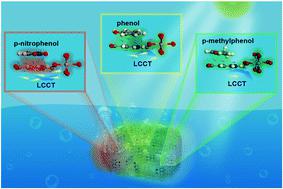当前位置:
X-MOL 学术
›
Environ. Sci.: Nano
›
论文详情
Our official English website, www.x-mol.net, welcomes your feedback! (Note: you will need to create a separate account there.)
Novel photocatalytic performance of nanocage-like MIL-125-NH2 induced by adsorption of phenolic pollutants
Environmental Science: Nano ( IF 7.3 ) Pub Date : 2020-03-20 , DOI: 10.1039/d0en00120a Yi Shen 1, 2, 3, 4, 5 , Chao Zhu 1, 2, 3, 4, 5 , Baoliang Chen 5, 6, 7, 8 , Jianmeng Chen 1, 2, 3, 4, 5 , Qile Fang 5, 9, 10, 11 , Jun Wang 5, 12, 13, 14, 15 , Zhiqiao He 1, 2, 3, 4, 5 , Shuang Song 1, 2, 3, 4, 5
Environmental Science: Nano ( IF 7.3 ) Pub Date : 2020-03-20 , DOI: 10.1039/d0en00120a Yi Shen 1, 2, 3, 4, 5 , Chao Zhu 1, 2, 3, 4, 5 , Baoliang Chen 5, 6, 7, 8 , Jianmeng Chen 1, 2, 3, 4, 5 , Qile Fang 5, 9, 10, 11 , Jun Wang 5, 12, 13, 14, 15 , Zhiqiao He 1, 2, 3, 4, 5 , Shuang Song 1, 2, 3, 4, 5
Affiliation

|
Adsorption–photocatalysis is a critical technique to meet the global challenges of environmental pollution and energy source shortages. However, scientific knowledge on how the adsorption process influences the subsequent photocatalytic performance is lacking. Here, we first propose a mechanism for understanding the intrinsic structure–performance relationship between phenolic pollutants and nanocage-like MIL-125-NH2 (NC-MIL-125-NH2) in adsorption–photocatalysis, from the perspective of electron induction. The experimental results, together with the density functional theory studies, soundly corroborate that the photocatalytic activity of NC-MIL-125-NH2 is enhanced and suppressed by the adsorption of electron-withdrawing pollutants i.e. p-nitrophenol and electron-donating pollutants i.e. p-methylphenol, respectively, which disagrees with conventional behavior. The mechanism is suitable to explain adsorption–photocatalysis behaviors when organic pollutants adsorb on the valence band of a photocatalytic material through π–π EDA interactions. These findings open new avenues for the design of functional materials for environmental and energy applications.
中文翻译:

酚类污染物的吸附诱导纳米笼状MIL-125-NH2的新型光催化性能
吸附-光催化是应对环境污染和能源短缺的全球挑战的一项关键技术。但是,缺乏关于吸附过程如何影响随后的光催化性能的科学知识。在这里,我们首先提出一种机制,用于从电子感应的角度理解吸附-光催化中酚类污染物与纳米笼状的MIL-125-NH 2(NC-MIL-125-NH 2)之间的固有结构-性能关系。实验结果与密度泛函理论研究一起,证实了NC-MIL-125-NH 2的光催化活性通过吸电子污染物即p的吸附得到增强和抑制。对硝基苯酚和给电子污染物,即对甲基苯酚,与常规行为不同。该机制适用于解释当有机污染物通过π-EDA相互作用吸附在光催化材料的价带上时的吸附-光催化行为。这些发现为环境和能源应用的功能材料设计开辟了新途径。
更新日期:2020-03-20
中文翻译:

酚类污染物的吸附诱导纳米笼状MIL-125-NH2的新型光催化性能
吸附-光催化是应对环境污染和能源短缺的全球挑战的一项关键技术。但是,缺乏关于吸附过程如何影响随后的光催化性能的科学知识。在这里,我们首先提出一种机制,用于从电子感应的角度理解吸附-光催化中酚类污染物与纳米笼状的MIL-125-NH 2(NC-MIL-125-NH 2)之间的固有结构-性能关系。实验结果与密度泛函理论研究一起,证实了NC-MIL-125-NH 2的光催化活性通过吸电子污染物即p的吸附得到增强和抑制。对硝基苯酚和给电子污染物,即对甲基苯酚,与常规行为不同。该机制适用于解释当有机污染物通过π-EDA相互作用吸附在光催化材料的价带上时的吸附-光催化行为。这些发现为环境和能源应用的功能材料设计开辟了新途径。


























 京公网安备 11010802027423号
京公网安备 11010802027423号